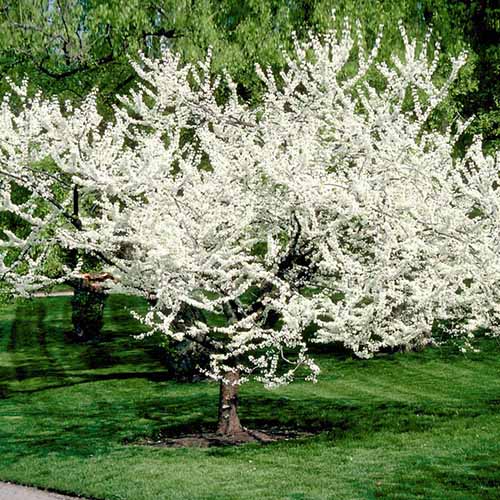Cercis spp.
Spring is a marvelously colorful time of year, with all the flowers and leaves unfolding as the days become warmer. And one of the brightest, boldest harbingers of spring is the redbud tree.
These showy bloomers send out flowers earlier than most other trees, and the color can last for weeks, completely covering the branches from trunk to tip.
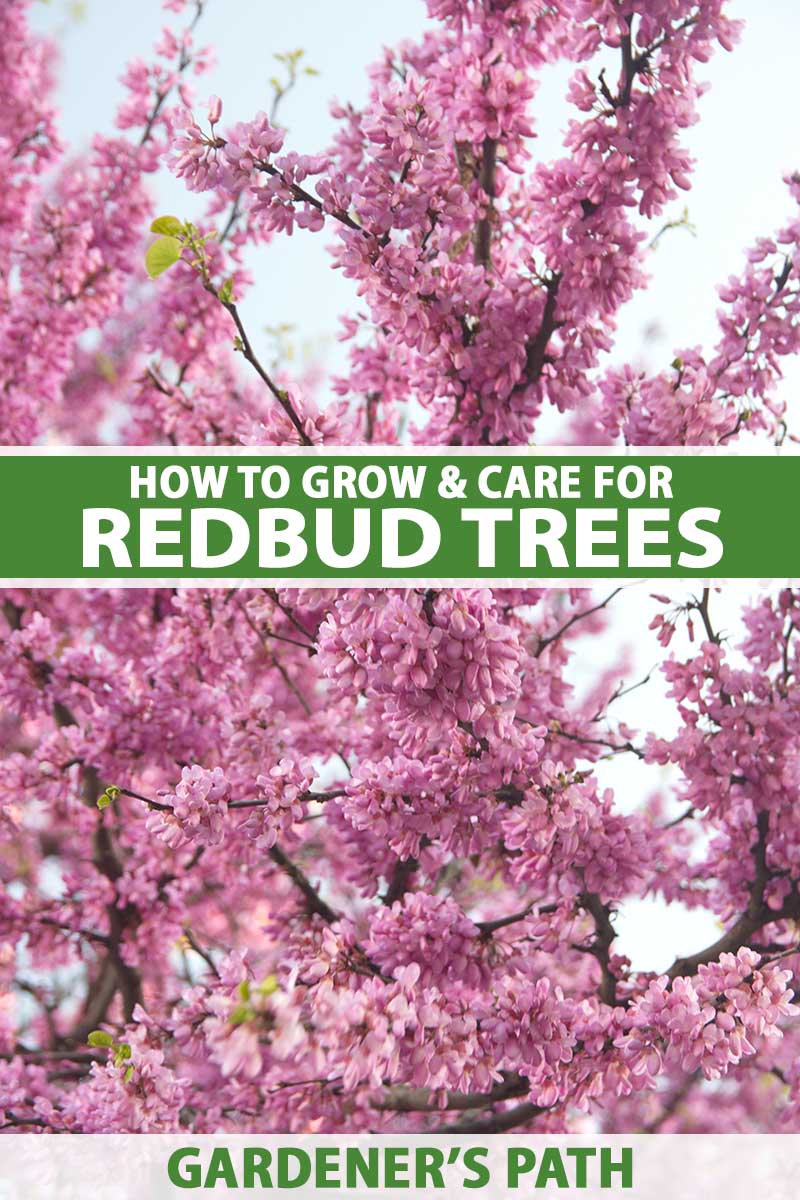
We link to vendors to help you find relevant products. If you buy from one of our links, we may earn a commission.
These trees can generally boast a good bill of health, stay fairly petite, and won’t become invasive, so you won’t be digging the roots out of your sewer pipes anytime soon.
They’re hardy down to USDA Zone 4 and up to Zone 9, and don’t need any special pruning or care.
In other words, there’s a lot to love about these plants and very little not to.
Of course, as with any plant, the redbud has its unique needs – especially if you want to enjoy the most dazzling display possible. We’ll talk about those needs and a lot more in this guide.
Here’s what’s coming:
What You’ll Learn
By the way, if you or someone you know is a budding forager, this is an excellent plant to start with.
It’s instantly recognizable in the spring and there aren’t any dangerous lookalikes.
More experienced foragers know that it’s also time to start hunting for morels when the blossoms are in bloom.
Cultivation and History
Redbud is the common name for plants in the Cercis genus, which is part of the Fabaceae family. If you know your botany, then you’ve probably realized this plant is a member of the legume family.
Yep, that’s right. The redbud tree is closely related to the humble garden pea.

It’s a little difficult to see the resemblance, but once you get a good look at the fruit pods or after you taste the seeds, flowers, or young leaves, you will more clearly understand this relationship.
Examine those inflorescences close up, and you’ll notice that they look a heck of a lot like pea flowers.
Black locust (Robinia pseudoacacia) and mimosa trees (Albizia julibrissin) are also in the same family.
Cercis canadensis, which is also known as the eastern redbud, is the one most commonly grown in the US.
This species is native to North America, with the largest wild populations clustered in an area spanning Iowa to Texas and points due east, though you can find them as far north as Canada and as far south as Mexico, and anywhere east of the Rockies.
There are three recognized varieties of eastern redbud: canadensis, texensis (Texas redbud), and mexicana (Mexican redbud).
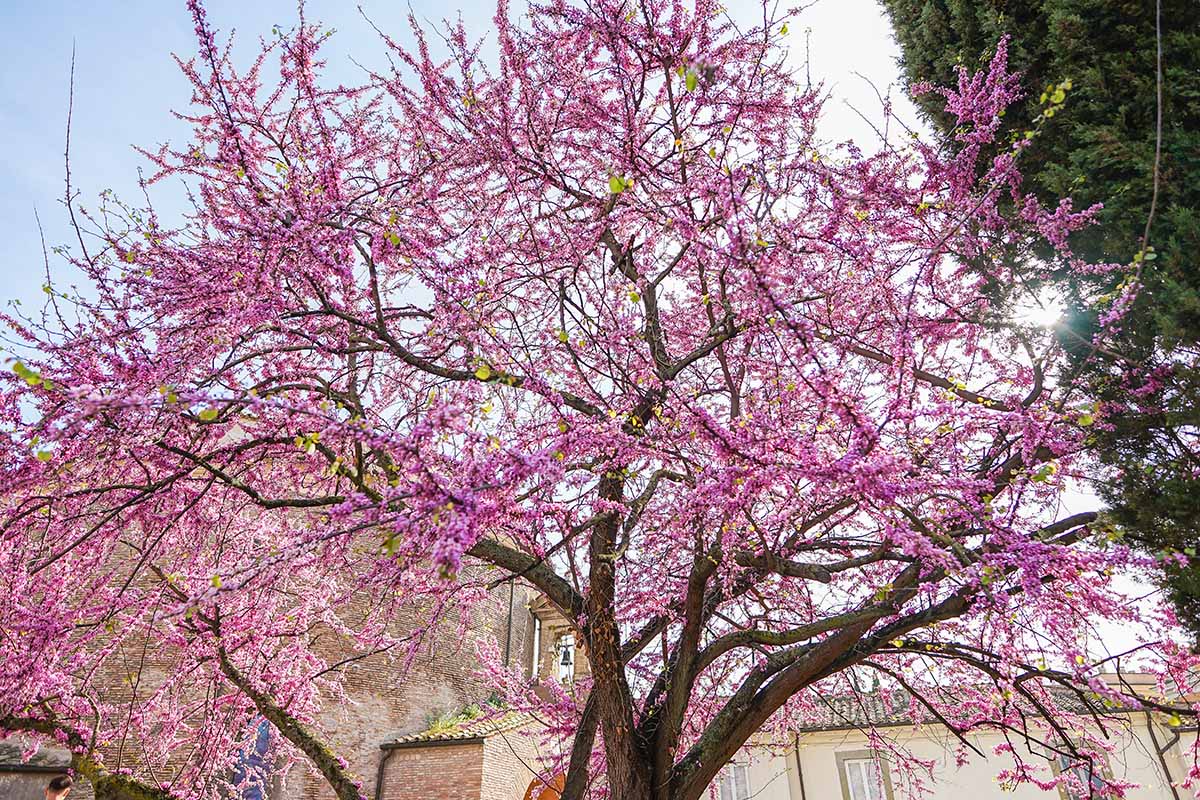
West of the Rockies, you’ll find C. occidentalis growing in the wild, where it is native. The western redbud isn’t as hardy as the eastern species and can only be grown as far north as Zone 6.
These, and species from Europe and Asia such as Judas tree (C. siliquastrum) and Chinese redbud (C. chinensis), are cultivated all over the US in Zones 4 to 9.
These small trees form masses of pink, mauve, magenta, or red flowers in the early spring before the purple-to-green heart-shaped foliage leafs out.
Flowers form on older wood on the trunk and stems rather than new growth, which is known as cauliflory.
After the flowers fade, seed pods begin to form and mature over the summer, though some cultivars are sterile so they won’t produce any fruit pods.
The branches have a slight zig-zagging growth pattern along the internodes, and there is one C. canadensis cultivar named Zig Zag® that has exaggerated zig-zagging.
In the wild, they tend to grow in the understory beneath larger trees, and as such, they prefer partial shade or partial sun and moist soil. However, many cultivars have been bred to do well in full sun or drought conditions.
Native people like the Alabama, Cherokee, and Delaware used the roots, bark, leaves, seeds, and flowers extensively for food and medicine.
Propagation
Redbuds are difficult to propagate and beginners should stick with buying a sapling or seedling at a nursery.
In addition to the following methods, it’s possible to propagate these via grafting, but it’s so unreliable and challenging that we don’t recommend it unless you’re already an expert grafter.
From Seed
Propagating seed takes some work. The seeds, which appear in the fall, need to be dried, scarified, and stratified before planting.
Then, you need to wait about two months for germination to take place.
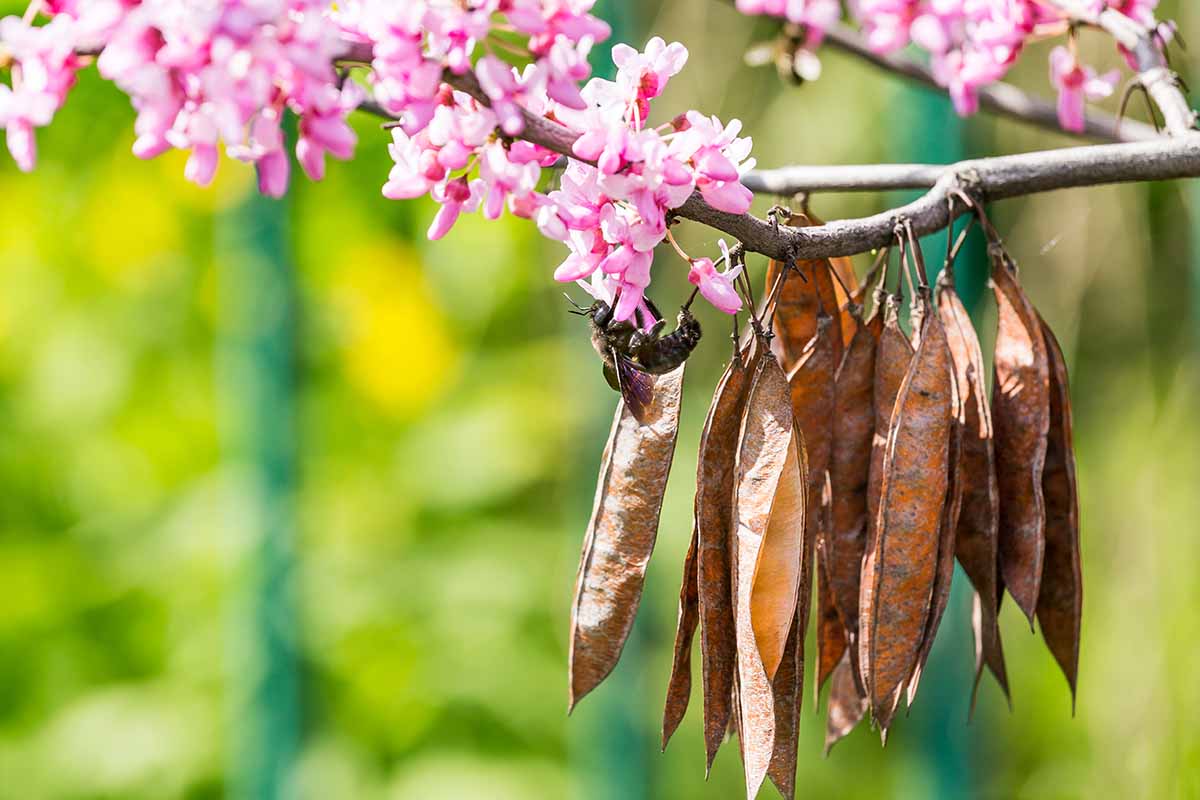
Not feeling daunted? Head out in the fall and look for the seed pods on a mature tree. They’re long and pea-pod shaped, and they should be brown at this point.
Collect and lay the pods on a screen or hang them from a piece of string to allow them to air dry.
After a few days, remove the seeds from inside the pods. Even if you only want to grow one tree, prepare several seeds just to be safe.
One option at this point is to soak the seeds in sulfuric acid for 30 minutes. You can often find this at stores sold in the drain cleaner aisle.
Don’t forget, this is strong, poisonous stuff, so heed all safety precautions on the label. That means wearing protective gear like gloves, eye protection, and a mask.
Or you can submerge the seeds in nearly boiling water held at 180°F for about a minute.
Drain and rinse the seeds carefully if you used acid, or drain and allow the seeds to cool if you prepared them in water.
Fill a jar or resealable bag with equal parts sand and sphagnum moss and moisten it so it feels like a well-wrung-out sponge. Bury the seeds in the sand, seal, and place the bag or jar in the fridge.
Occasionally check to make sure the sand mix is moist and there’s no mold forming. If you see mold, remove the seeds and place them in fresh sand in a clean bag or jar.
After about five weeks – though it might take up to 10 weeks – you should start to see growth. The second you see growth emerging from a seed, plant it.
To do this, fill a six-inch compostable pot with potting mix. Sow one germinated seed a quarter-inch deep in each container.
Place the containers outside in a spot that receives partial sun, about six hours per day. Bring them back inside any time the temperature drops below 35°F.
Once a seedling is about six inches tall, you can plant it in the ground. It’s best to transplant either in the fall or spring, and you should avoid planting in the winter or summer.
From Cuttings
It is possible to propagate redbuds from cuttings, but they don’t take reliably, which is why growers tend to rely on propagating seed when possible instead.
If you carefully control the environment, you might have a higher rate of success.
In early summer, take a few six-inch cuttings of soft, pliable wood from the tips of healthy branches. Place the cuttings in water until you get them inside and are ready to plant, which you should do right away.
When you’re ready, cut the end of each at a 45-degree angle, remove any leaves from the bottom half, and dip the cut ends in a rooting hormone.
The rooting hormone step is optional for propagating some types of plants, but it’s mandatory in this case to improve your chances of success.
Plant each cutting an inch or two deep in a six-inch pot filled with potting soil.
Place the pots on a heated mat to keep the soil at 72 to 78°F. If the soil temperature drops into the 60s, rooting success rates drop off dramatically.
You also need to keep the cuttings humid for successful propagation.
The easiest way to do this is to cover them with a cloche or other type of cover and mist them daily. You can also use a humidifier.
Keep the cuttings in a place where they’ll receive six hours per day of supplemental lighting.
Electric grow lights are preferred to natural sunlight here because you can regulate the exposure, and LED bulbs won’t heat the soil or interior of the cover excessively like direct sunlight might.
Transplanting Saplings or Bare Roots
Planting a sapling or bare root tree is best done in the early spring or late fall when the ground is workable.
Pick a spot with the right sun exposure and spacing from other plants or structures – we’ll discuss this in more detail in the How to Grow section below.
Once you’ve nailed down the right spot, dig away. Make sure you aren’t digging into any utility cables.
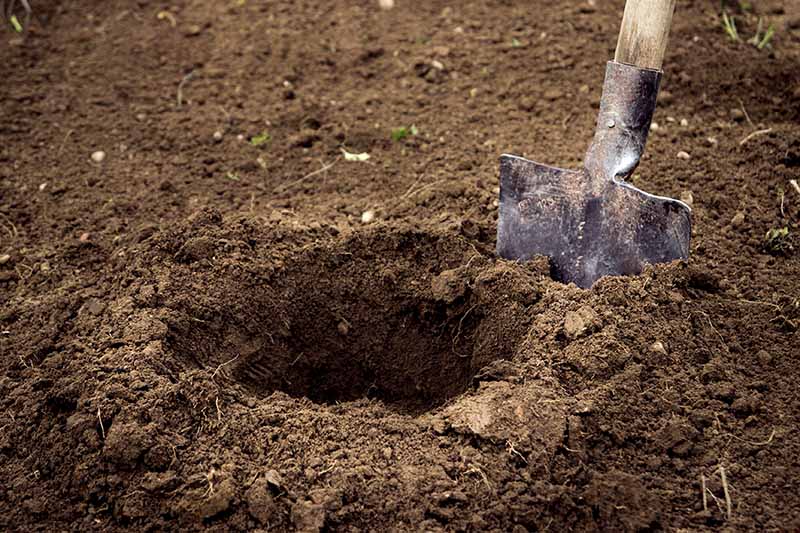
Dig a hole that is twice as wide and twice as deep as the container that the sapling is currently growing in, or three times as wide and twice as deep as the rootball.
Fill in the bottom half of the hole with a mixture of well-rotted compost and native soil.
Remove the sapling from the container and gently loosen up the roots. Place it in the hole, and make sure it’s sitting at the same level that it was inside the container.
For bare root plants, the entire root ball should be buried sitting just below the soil line. The trunk can not tolerate being buried at all.
You don’t want the plant to be positioned any deeper or more shallow than it was before if it came in a pot filled with soil from the nursery. If necessary, adjust the quantity of soil in the base of the hole.
Fill in around the sides with a mixture of compost and native soil. Firm the soil around the roots and water well. If the soil settles, add a bit more.
How to Grow Redbud Trees
Most cultivars flower best in full sun in cooler regions, or partial shade in hotter regions. If you want to ensure that your tree thrives, choose a cultivar or variety that is well-adapted to your climate.
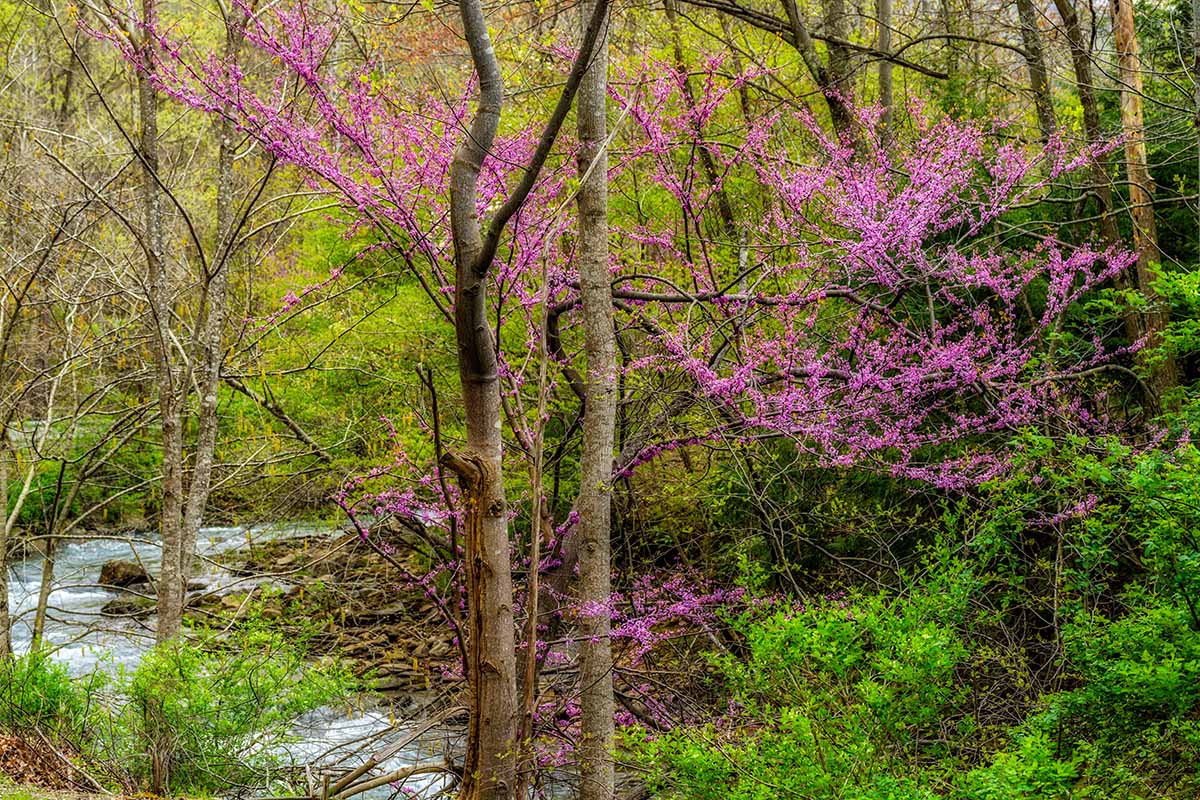
For instance, C. canadensis var. mexicana and cultivars bred from it are better off in warmer climates, while C. canadensis var. canadensis and its progeny do better in cooler ones.
You’re also better off choosing whatever species is native to your region, whenever possible.
To really be happy, these trees need a certain number of chill hours at or below 45°F, and the exact amount will vary depending on the cultivar.
Once again, pick a cultivar or variety that will tolerate fewer chill hours if you live somewhere with mild winters.
‘Pink Pom Pom,’ for instance, has some texensis lineage which makes it more tolerant of warmer winters, and it will still produce flowers despite the warmer climate.
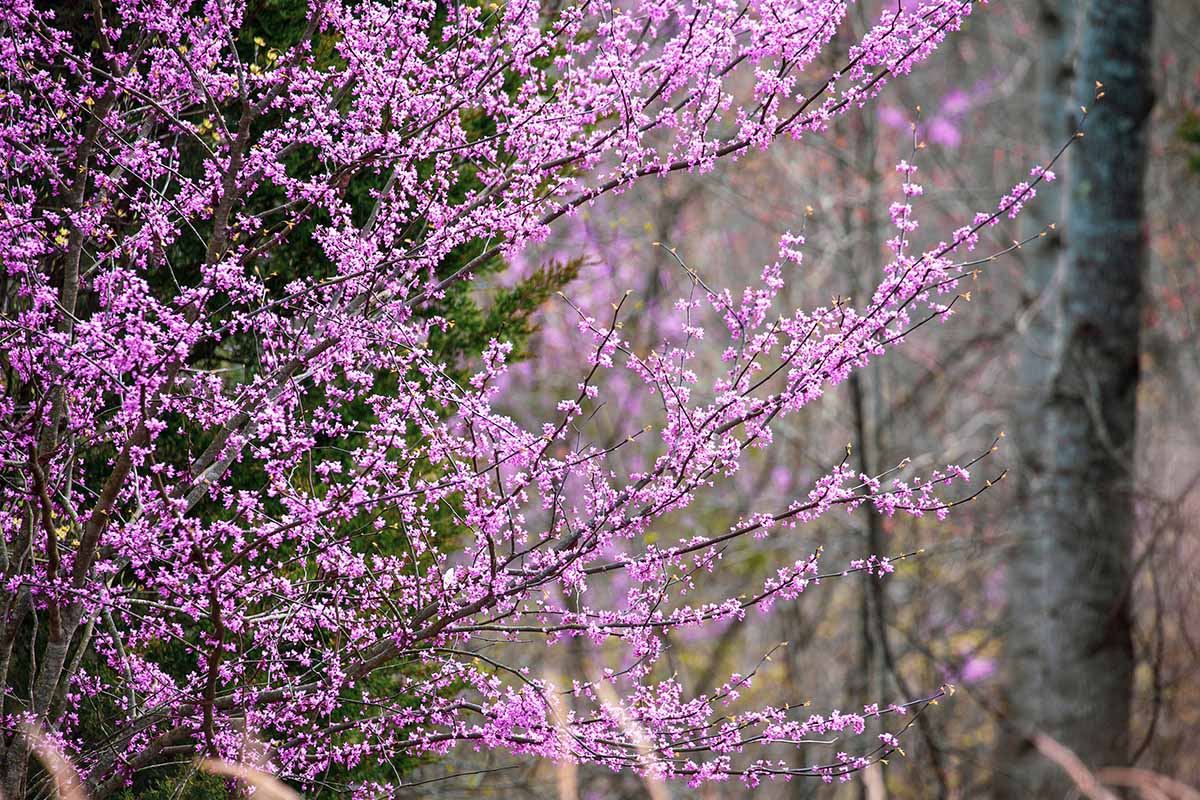
The soil in the planting area needs to be well-draining. These trees can tolerate a range of soils, so long as it’s well draining with a pH between 6.5 and 8.0.
Some hybrids and cultivars are more drought tolerant than others, but all established redbuds can handle some amount of drought. Western redbuds are extremely drought tolerant and can go without any supplemental water in many parts of the US.
As a general rule of thumb, you should provide water when the soil feels dry three inches down, and the soil should never be soggy.
During the growing season, feed your plant every other month with a mild, balanced fertilizer.
Fertilizer gives the plant the energy it needs to grow and store up nutrients for that brilliant display next spring.
A 10-10-10 NPK fertilizer, or something close to that, is ideal.
Pendleton Turf Triple 10 is a good option that will keep a wide variety of species happy with its special formulation of amino acids and seaweed extract.

Pick up a 32-ounce bottle from Amazon.
If you decide to grow one of these trees in a container, pick one of the smaller cultivars.
Depending on the size of the container, you can expect the tree to stay within about half the size of one of the same variety growing in the ground, so a 12-foot type will generally stay within a manageable six feet.
Choose a container at least 18 inches wide and 24 inches deep, with at least one or preferably multiple drainage holes. Plan to keep the container in a permanent spot.
Though you could move it around if the pot’s placed on casters, it’s going to be difficult to move such a large container easily when it’s filled.
Fill the container with water-retentive potting soil. Remember, redbuds aren’t terribly demanding about soil, but it never hurts to give them the good stuff.

FoxFarm Ocean Forest Potting Mix
I’m a huge fan of FoxFarm Ocean Forest potting mix, which is available at Amazon in 12-quart bags.
I find this mix to be perfect for a wide range of plants and it’s produced in a sustainable way.
Pots won’t help to insulate roots against cold temperatures to the same degree as ground soil, so pretend you live in an area one Zone lower than your actual garden location if you’re using a pot.
In other words, if you live in Zone 7, choose a plant that’s hardy down to Zone 6. You also need to keep a closer eye on the soil since it will dry out faster.
Growing Tips
- Water when the top three inches of soil dry out.
- Plant in partial shade to full sun.
- Feed every two months from spring until fall.
Pruning and Maintenance
Remember, these plants are cauliflorous. The flowers and seed pods form on old, woody growth. That means you don’t have to do any special pruning to encourage flowering and fruiting.

Unless a branch breaks or is diseased or dead, it’s best to just leave the tree alone.
You can always prune crossing or rubbing branches to open the canopy and improve the appearance. This should be done in early spring before flowering.
Redbud Cultivars to Select
It’s an exciting period for redbuds when it comes to discovering new varieties and breeding new cultivars.
So many beautiful and unique cultivars are hitting the market, with impressive blossoms and foliage so attractive that the flowers sometimes take a backseat.
We’ll cover more of these in a future roundup. Here are just a few, to whet your appetite:
Flame Thrower
Fall is always an exciting time, with the bright foliage covering all of the many deciduous trees in the landscape.
But sometimes it might be nice to see a little of that color during the summer. That’s when you plant Flame Thrower®.

This C. canadensis cultivar has bright red and burgundy leaves during the spring and summer that turn orange and gold in the fall.
Add to that the lovely pinkish-purple blossoms in the spring, and you have a tree that is showing off for a majority of the year. It reaches about 20 feet tall once mature.
The fact that it’s extremely drought-tolerant and will perform even in partial sun just goes to show how excellent this cultivar is.
Bred by Denny Werner at North Carolina State University, you don’t even need the flowers to enjoy this tree – the leaves are stunning enough to steal the show!
Plant in Zones 5 to 9. It needs 30 days with temperatures below 50°F to produce flowers.
Add some heat to your life and grab a four- to five-, five- to six-, or six- to seven-foot-tall tree at Planting Tree.
Oklahoma
‘Oklahoma’ is a C. canadensis var. canadensis with texensis lineage, so it’s more heat and drought tolerant than other redbuds, perfect in Zones 6 to 10a.
The flowers are shockingly vibrant rose-red, with waxy heart-shaped leaves.
This is a larger cultivar that can stretch up to 25 feet tall, but typically stays smaller. If you’re a southern gardener dreaming of a redbud that won’t falter in your landscape, this is the one.
All eastern redbuds require 30 days with temperatures below 50°F, but ‘Oklahoma’ will often produce blooms even if it doesn’t receive a full 700 chill hours.
Grab a three- to four-foot-tall tree in a #5 container at Planting Tree.
Royal White
Redbuds, as their common name would suggest, have a reputation for featuring red or pink flowers.
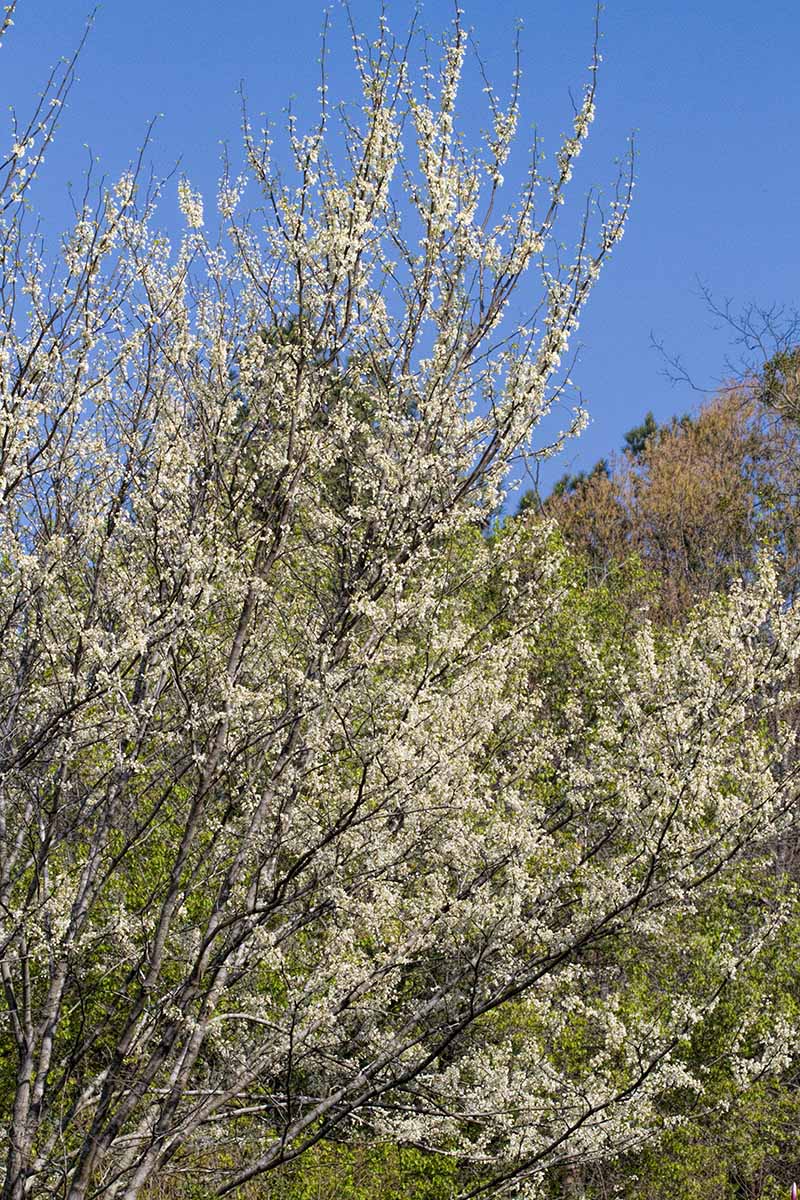
But this cultivar dazzles with pure-white blossoms covering a 30-foot-tall tree at maturity. It’s cold tolerant down to Zone 4 and has a compact, rounded growth habit.
To produce blossoms, this tree needs 30 days of temperatures below 50°F.
Snag one of these C. canadensis cultivars at FastGrowingTrees.com.
Managing Pests and Disease
In general, this is one of those trees that generally maintains good health so long as you grow it in the right environment. If problems do come up, here’s what you’re most likely to see:
Herbivores
More so than diseases or insect pests, avoiding herbivores is going to be the biggest challenge to overcome when growing redbuds.
Those animals out there seem like they’re all too eager to get a bite of your plant. Both deer and rabbits will devour young trees if given the chance.
Your best bet to protect your redbuds from both of these common pests is to surround the young trees with chicken wire.
Once your tree is tall enough that the leaves and branches are out of reach and safe from browsing, you can remove the fence.
Insects
Redbuds are generally ignored by insect pests, especially if you choose a species native to your region.
However, that seems to be changing as the dreaded emerald ash borer expands its range into more and more regions.
Regardless, healthy trees are usually able to withstand an infestation and remain healthy.
Leaf Rollers
The redbud leaf roller (Fascista cercerisella) is the larva of a half-inch-wide dark brown and white moth that lives east of the Rocky Mountains.
The moth itself isn’t a threat, but the half-inch-long black and white leaf rollers will roll up redbud leaves in loose webbing, eventually killing them.

To control this pest, just pull off any rolled leaves, bag them, and dispose of them.
Sprays won’t usually work since the larvae hide in the little shelters that they’ve made. Fortunately, they don’t typically cause serious damage.
Emerald Ash Borers
The emerald ash borer (Agrilus planipennis) is an invasive pest from Asia that is rapidly invading a larger and larger area of North America.
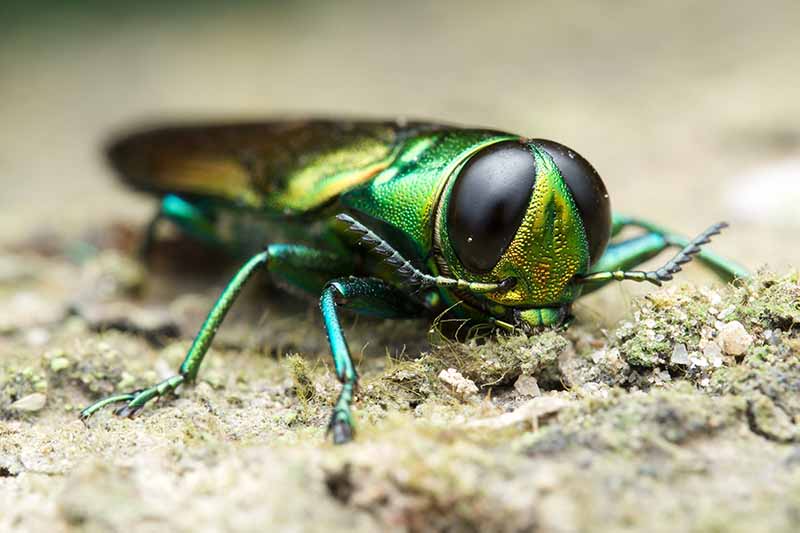
It was first identified in southeast Michigan in 2002, and identified on the West Coast for the first time in 2022. In the intervening years, it spread through every state east of the Rockies and throughout Colorado.
There have been reports since of these pests in Montana and Wyoming.
Though they haven’t been officially confirmed at the time of this writing, this indicates that it’s possible that the bug may be found in every state throughout the continental US.
They decimate ash trees, killing hundreds of millions since they were first discovered in North America 20 years ago, but they’ve also been seen feeding on the leaves of redbuds and other species.
These beetles look like iridescent half-inch-long grasshoppers. Hand pick and drown any you see in soapy water.
If you have ash trees on your property and you spot these pests, you’ll need to start treatment right away. With redbuds, your best line of attack is to keep your tree healthy.
Disease
It’s rare that a redbud is impacted by disease, but that doesn’t mean it can’t happen.
Trees growing in wet soil, with poor air circulation, or those that are fed incorrectly are more likely to face issues.
Canker
Canker on redbuds is caused by fungi in the Botryosphaeria genus, and it’s the most destructive disease of the Cercis species.
At first, it shows up as little black, soft, sunken spots in the bark. Eventually, the canker spreads and girdles the stem, causing everything above the canker to die.
Fungicides aren’t extremely effective, so just prune away any diseased branches you see at the base.
If you have a severe case with lots of cankers and dying branches, you will need to just remove the tree.
Verticillium
Caused by the fungus Verticillium albo-atrum, vert causes the leaves to wilt even when the tree has plenty of water.
As the disease progresses, the leaves turn yellow and may form V-shaped yellow spots between the veins. Overfertilizing and wet soil creates favorable conditions for this disease.
Sadly, there is no treatment available. It’s best to remove an infected plant and dispose of it.
Best Uses for Redbud Trees
First, let’s talk about how to eat this tree. You can eat the young leaves and flowers either raw or cooked.
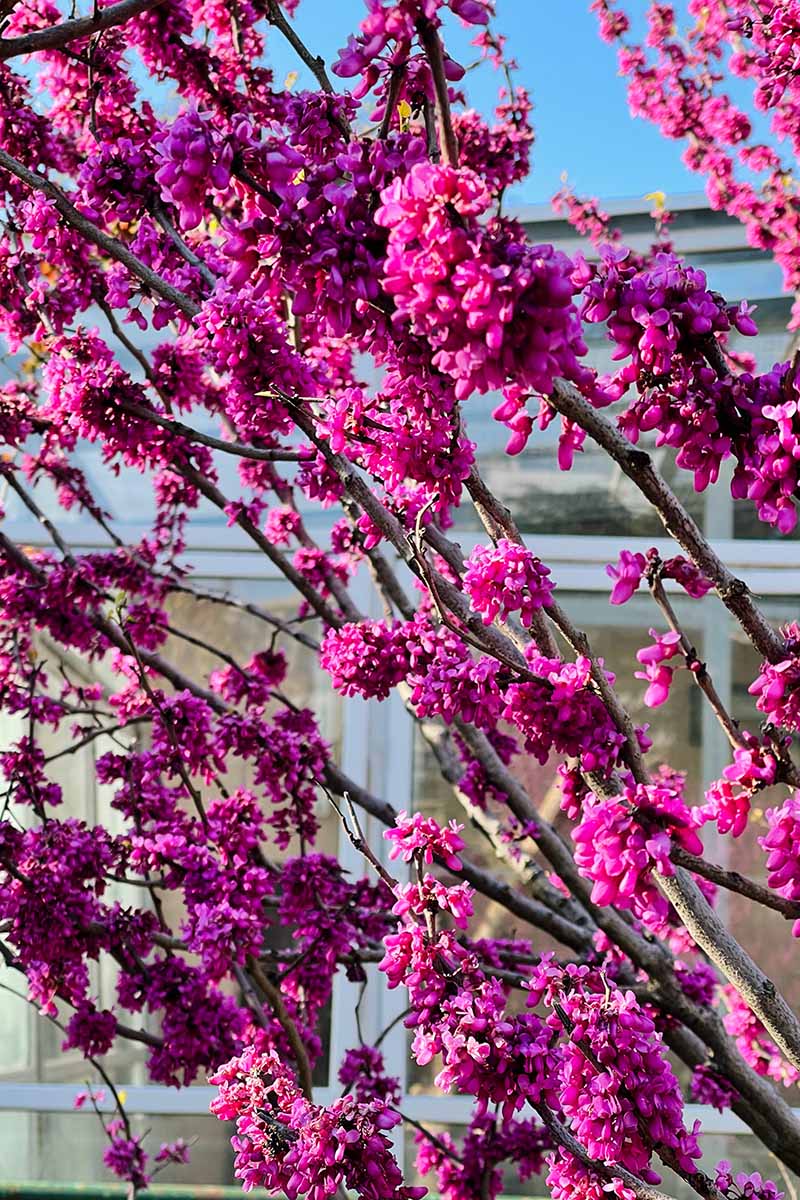
The leaves aren’t all that great, if I’m being totally honest.
The really young ones have a mild flavor and tender texture, but otherwise, they tend to be largely flavorless or slightly bitter. They make a good salad filler, though!
The pods are also edible, but they’re best when they’re young and tender. Sautee them or toss them raw into salads. Basically, you can use them as you would edible pea pods.
The blossoms are the tastiest part of the plant. These are firm enough to fry up well yet tender enough to also eat raw.
If you prefer a sweeter, more tender treat, just eat the paler upper petals. You can also pickle the flower buds to make “capers.”
Humans aren’t the only ones who love foraging from these trees!
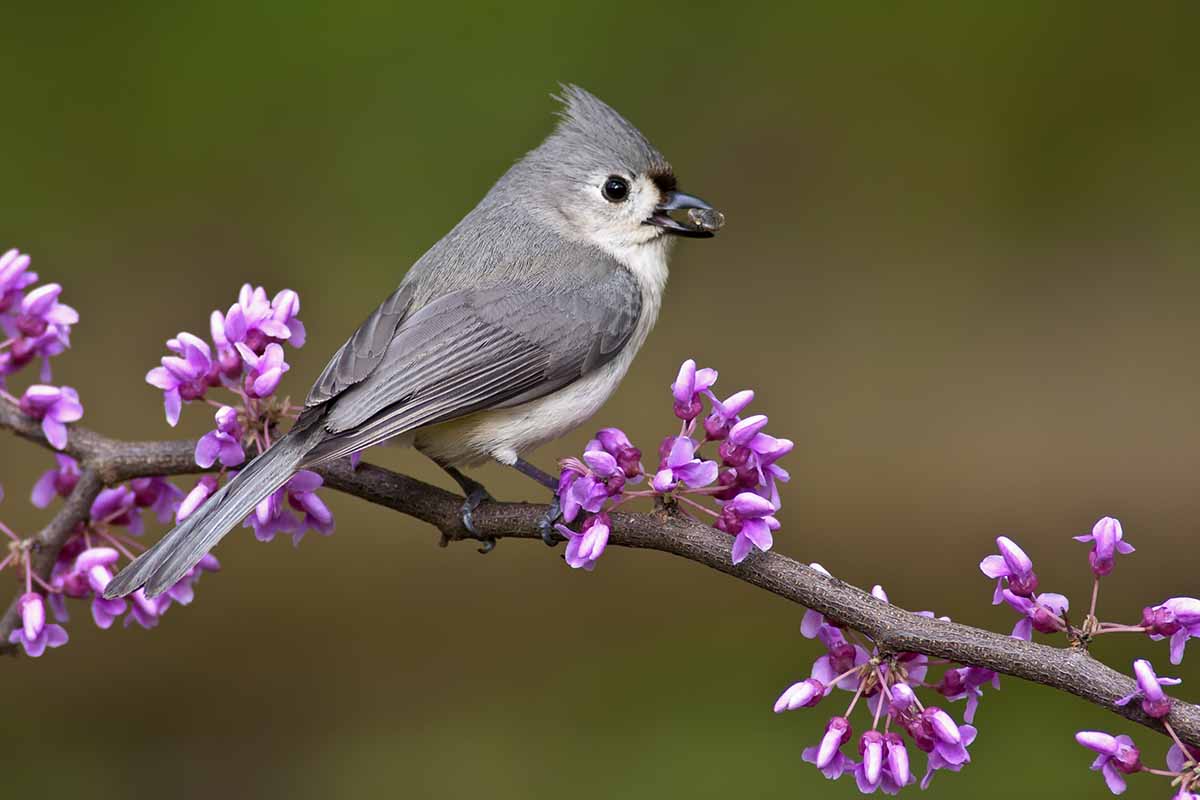
The flowers are pollinated by bees, though only long-tongued bees can reach deep enough to access the nectar.
Butterflies and hummingbirds also feed on the flowers. In fact, C. canadensis is the main host of Henry’s elfin butterflies (Callophrys henrici).
In the garden, these make excellent specimen trees and the semi-dwarf cultivars are perfect in containers.
If you have a partially shaded spot that needs a burst of color, a redbud is an awesome pick.
Plant some partial-shade-loving color like phlox, wood lilies, violets, or bluebells underneath.
Quick Reference Growing Guide
| Plant Type: | Deciduous, cauliflorous tree | Flower/Foliage Color: | Pink, lavender, red, white/green, red, maroon |
| Native to: | North America, Europe, China | Maintenance: | Low |
| Hardiness (USDA Zones): | 4-10a, varies depending on species | Tolerance | Drought |
| Bloom Time: | Spring blooms/fall foliage | Soil Type: | Sandy, loamy |
| Exposure: | Part shade to full sun | Soil pH: | 6.5-8.0 |
| Time to Maturity: | 10 years | Soil Drainage: | Well-draining |
| Spacing: | 5-15 feet | Attracts: | Bees, butterflies, hummingbirds |
| Planting Depth: | 1/4 inch (seeds), same depth as container (transplants), roots just below the soil line (bare root) | Companion Planting: | Bluebells, phlox, violets, wood lilies |
| Height: | Up to 30 feet, depending on variety | Uses: | Container, edible, specimen |
| Spread: | Up to 30 feet, depending on variety | Family: | Fabaceae |
| Growth Rate: | Fast | Genus: | Cercis |
| Water Needs: | Moderate to low | Species: | Canadensis, chinenis, occidentalis, siliquastrum |
| Common Pests and Diseases: | Emerald ash borers, deer, leaf rollers, rabbits; canker, verticillium wilt | Varieties: | Canadensis, mexicana, texensis |
Usher in Spring with Redbud Trees
The first tree I ever planted was a redbud. And I had no idea what I was doing.
I had just moved out of my parents’ house and I wanted a tree to fill the empty dry patch just beyond the reach of the sprinklers at my rental.

I did everything wrong. It was the wrong spot, with poor drainage and concrete-hard soil.
I didn’t have a garden hose, so the irrigation it received was intermittent at best. Between the rush of college and time spent hanging out with friends, I forgot to feed it.
Of course, now I know better – and you do, too! But I think my story is a testament to how tough redbud trees are. The one I planted way back when is still growing away happily for the current tenants to enjoy.
I can’t wait to hear which cultivar or species you’re going to go with. If I could, I’d plant one of each, so you’ll have to share in the comments so I can live vicariously through you.
Did this guide help you achieve your redbud dreams? I sincerely hope so. If you want to add more trees to your landscape, you might find the following guides helpful:


